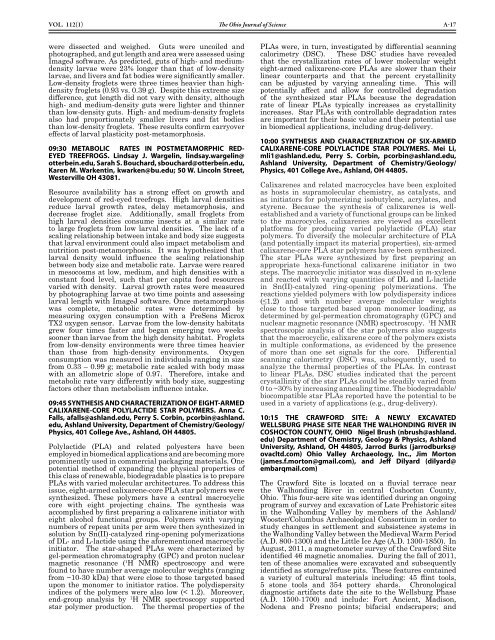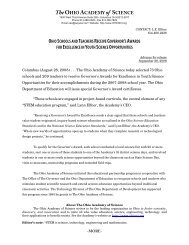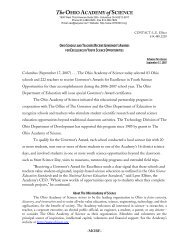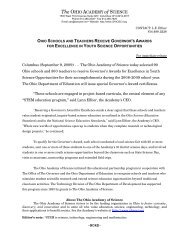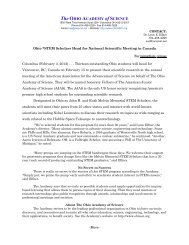The Ohio Journal of - The Ohio Academy of Science
The Ohio Journal of - The Ohio Academy of Science
The Ohio Journal of - The Ohio Academy of Science
Create successful ePaper yourself
Turn your PDF publications into a flip-book with our unique Google optimized e-Paper software.
Vol. 112(1)<br />
were dissected and weighed. Guts were uncoiled and<br />
photographed, and gut length and area were assessed using<br />
ImageJ s<strong>of</strong>tware. As predicted, guts <strong>of</strong> high- and mediumdensity<br />
larvae were 23% longer than that <strong>of</strong> low-density<br />
larvae, and livers and fat bodies were significantly smaller.<br />
Low-density froglets were three times heavier than highdensity<br />
froglets (0.93 vs. 0.39 g). Despite this extreme size<br />
difference, gut length did not vary with density, although<br />
high- and medium-density guts were lighter and thinner<br />
than low-density guts. High- and medium-density froglets<br />
also had proportionately smaller livers and fat bodies<br />
than low-density froglets. <strong>The</strong>se results confirm carryover<br />
effects <strong>of</strong> larval plasticity post-metamorphosis.<br />
09:30 METABOLIC RATES IN POSTMETAMORPHIC RED-<br />
EYED TREEFROGS. Lindsay J. Wargelin, lindsay.wargelin@<br />
otterbein.edu, Sarah S. Bouchard, sbouchard@otterbein.edu,<br />
Karen M. Warkentin, kwarken@bu.edu; 50 W. Lincoln Street,<br />
Westerville OH 43081.<br />
Resource availability has a strong effect on growth and<br />
development <strong>of</strong> red-eyed treefrogs. High larval densities<br />
reduce larval growth rates, delay metamorphosis, and<br />
decrease froglet size. Additionally, small froglets from<br />
high larval densities consume insects at a similar rate<br />
to large froglets from low larval densities. <strong>The</strong> lack <strong>of</strong> a<br />
scaling relationship between intake and body size suggests<br />
that larval environment could also impact metabolism and<br />
nutrition post-metamorphosis. It was hypothesized that<br />
larval density would influence the scaling relationship<br />
between body size and metabolic rate. Larvae were reared<br />
in mesocosms at low, medium, and high densities with a<br />
constant food level, such that per capita food resources<br />
varied with density. Larval growth rates were measured<br />
by photographing larvae at two time points and assessing<br />
larval length with ImageJ s<strong>of</strong>tware. Once metamorphosis<br />
was complete, metabolic rates were determined by<br />
measuring oxygen consumption with a PreSens Microx<br />
TX2 oxygen sensor. Larvae from the low-density habitats<br />
grew four times faster and began emerging two weeks<br />
sooner than larvae from the high density habitat. Froglets<br />
from low-density environments were three times heavier<br />
than those from high-density environments. Oxygen<br />
consumption was measured in individuals ranging in size<br />
from 0.33 – 0.99 g; metabolic rate scaled with body mass<br />
with an allometric slope <strong>of</strong> 0.97. <strong>The</strong>refore, intake and<br />
metabolic rate vary differently with body size, suggesting<br />
factors other than metabolism influence intake.<br />
09:45 SYNTHESIS AND CHARACTERIzATION OF EIGHT-ARMED<br />
CALIXARENE-CORE POLYLACTIDE STAR POLYMERS. Anna C.<br />
Falls, afalls@ashland.edu, Perry S. Corbin, pcorbin@ashland.<br />
edu, Ashland University, Department <strong>of</strong> Chemistry/Geology/<br />
Physics, 401 College Ave., Ashland, OH 44805.<br />
Polylactide (PLA) and related polyesters have been<br />
employed in biomedical applications and are becoming more<br />
prominently used in commercial packaging materials. One<br />
potential method <strong>of</strong> expanding the physical properties <strong>of</strong><br />
this class <strong>of</strong> renewable, biodegradable plastics is to prepare<br />
PLAs with varied molecular architectures. To address this<br />
issue, eight-armed calixarene-core PLA star polymers were<br />
synthesized. <strong>The</strong>se polymers have a central macrocyclic<br />
core with eight projecting chains. <strong>The</strong> synthesis was<br />
accomplished by first preparing a calixarene initiator with<br />
eight alcohol functional groups. Polymers with varying<br />
numbers <strong>of</strong> repeat units per arm were then synthesized in<br />
solution by Sn(II)-catalyzed ring-opening polymerizations<br />
<strong>of</strong> DL- and L-lactide using the aforementioned macrocyclic<br />
initiator. <strong>The</strong> star-shaped PLAs were characterized by<br />
gel-permeation chromatography (GPC) and proton nuclear<br />
magnetic resonance ( 1 H NMR) spectroscopy and were<br />
found to have number average molecular weights (ranging<br />
from ~10-30 kDa) that were close to those targeted based<br />
upon the monomer to initiator ratios. <strong>The</strong> polydispersity<br />
indices <strong>of</strong> the polymers were also low (< 1.2). Moreover,<br />
end-group analysis by 1 H NMR spectroscopy supported<br />
star polymer production. <strong>The</strong> thermal properties <strong>of</strong> the<br />
<strong>The</strong> <strong>Ohio</strong> <strong>Journal</strong> <strong>of</strong> <strong>Science</strong> A-17<br />
PLAs were, in turn, investigated by differential scanning<br />
calorimetry (DSC). <strong>The</strong>se DSC studies have revealed<br />
that the crystallization rates <strong>of</strong> lower molecular weight<br />
eight-armed calixarene-core PLAs are slower than their<br />
linear counterparts and that the percent crystallinity<br />
can be adjusted by varying annealing time. This will<br />
potentially affect and allow for controlled degradation<br />
<strong>of</strong> the synthesized star PLAs because the degradation<br />
rate <strong>of</strong> linear PLAs typically increases as crystallinity<br />
increases. Star PLAs with controllable degradation rates<br />
are important for their basic value and their potential use<br />
in biomedical applications, including drug-delivery.<br />
10:00 SYNTHESIS AND CHARACTERIzATION OF SIX-ARMED<br />
CALIXARENE-CORE POLYLACTIDE STAR POLYMERS. Mei Li,<br />
mli1@ashland.edu, Perry S. Corbin, pcorbin@ashland.edu,<br />
Ashland University, Department <strong>of</strong> Chemistry/Geology/<br />
Physics, 401 College Ave., Ashland, OH 44805.<br />
Calixarenes and related macrocycles have been exploited<br />
as hosts in supramolecular chemistry, as catalysts, and<br />
as initiators for polymerizing isobutylene, acrylates, and<br />
styrene. Because the synthesis <strong>of</strong> calixarenes is wellestablished<br />
and a variety <strong>of</strong> functional groups can be linked<br />
to the macrocycles, calixarenes are viewed as excellent<br />
platforms for producing varied polylactide (PLA) star<br />
polymers. To diversify the molecular architecture <strong>of</strong> PLA<br />
(and potentially impact its material properties), six-armed<br />
calixarene-core PLA star polymers have been synthesized.<br />
<strong>The</strong> star PLAs were synthesized by first preparing an<br />
appropriate hexa-functional calixarene initiator in two<br />
steps. <strong>The</strong> macrocyclic initiator was dissolved in m-xylene<br />
and reacted with varying quantities <strong>of</strong> DL and L-lactide<br />
in Sn(II)-catalyzed ring-opening polymerizations. <strong>The</strong><br />
reactions yielded polymers with low polydispersity indices<br />
(≤1.2) and with number average molecular weights<br />
close to those targeted based upon monomer loading, as<br />
determined by gel-permeation chromatography (GPC) and<br />
nuclear magnetic resonance (NMR) spectroscopy. 1 H NMR<br />
spectroscopic analysis <strong>of</strong> the star polymers also suggests<br />
that the macrocyclic, calixarene core <strong>of</strong> the polymers exists<br />
in multiple conformations, as evidenced by the presence<br />
<strong>of</strong> more than one set signals for the core. Differential<br />
scanning calorimetry (DSC) was, subsequently, used to<br />
analyze the thermal properties <strong>of</strong> the PLAs. In contrast<br />
to linear PLAs, DSC studies indicated that the percent<br />
crystallinity <strong>of</strong> the star PLAs could be steadily varied from<br />
0 to ~30% by increasing annealing time. <strong>The</strong> biodegradable/<br />
biocompatible star PLAs reported have the potential to be<br />
used in a variety <strong>of</strong> applications (e.g., drug-delivery).<br />
10:15 THE CRAWFORD SITE: A NEWLY EXCAVATED<br />
WELLSBURG PHASE SITE NEAR THE WALHONDING RIVER IN<br />
COSHOCTON COUNTY, OHIO Nigel Brush (nbrush@ashland.<br />
edu) Department <strong>of</strong> Chemistry, Geology & Physics, Ashland<br />
University, Ashland, OH 44805, Jarrod Burks (jarrodburks@<br />
ovacltd.com) <strong>Ohio</strong> Valley Archaeology, Inc., Jim Morton<br />
(james.f.morton@gmail.com), and Jeff Dilyard (dilyard@<br />
embarqmail.com)<br />
<strong>The</strong> Crawford Site is located on a fluvial terrace near<br />
the Walhonding River in central Coshocton County,<br />
<strong>Ohio</strong>. This four-acre site was identified during an ongoing<br />
program <strong>of</strong> survey and excavation <strong>of</strong> Late Prehistoric sites<br />
in the Walhonding Valley by members <strong>of</strong> the Ashland/<br />
Wooster/Columbus Archaeological Consortium in order to<br />
study changes in settlement and subsistence systems in<br />
the Walhonding Valley between the Medieval Warm Period<br />
(A.D. 800-1300) and the Little Ice Age (A.D. 1300-1850). In<br />
August, 2011, a magnetometer survey <strong>of</strong> the Crawford Site<br />
identified 46 magnetic anomalies. During the fall <strong>of</strong> 2011,<br />
ten <strong>of</strong> these anomalies were excavated and subsequently<br />
identified as storage/refuse pits. <strong>The</strong>se features contained<br />
a variety <strong>of</strong> cultural materials including: 45 flint tools,<br />
5 stone tools and 354 pottery shards. Chronological<br />
diagnostic artifacts date the site to the Wellsburg Phase<br />
(A.D. 1500-1700) and include: Fort Ancient, Madison,<br />
Nodena and Fresno points; bifacial endscrapers; and


